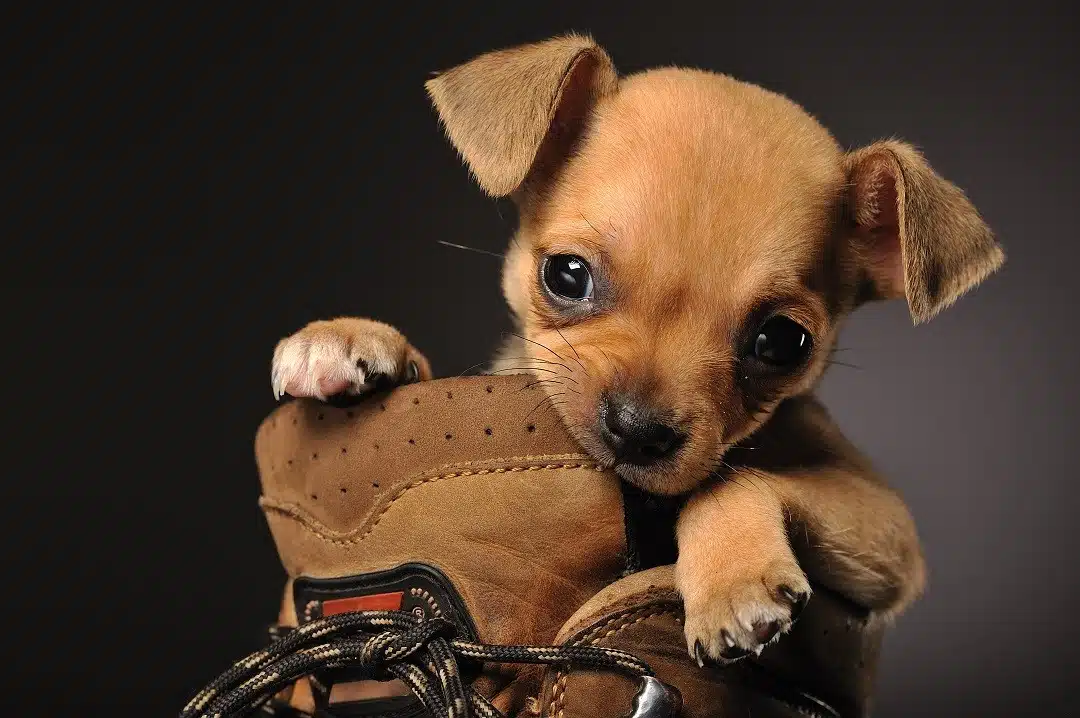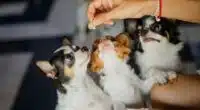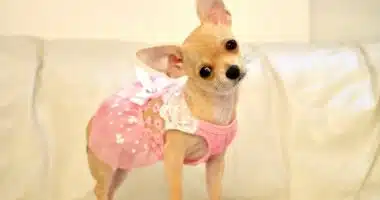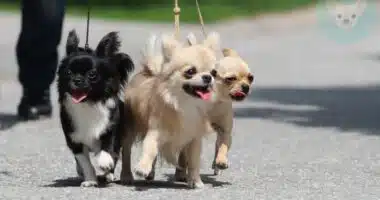If a Chihuahua is displaying destructive chewing, nothing is off-limits. Pee pads may be ripped, furniture may be gnawed on, and essentially every non-toy object within the Chihuahua’s reach is a possible target.
Chihuahuas may chew things up for a number of reasons including teething, as a way to alleviate boredom or restlessness, or as a method of coping with stress.
This section will cover the exact steps to stop a Chihuahua from chewing both small and large objects in the house, no matter the root cause.
What Triggers Destructive Chewing
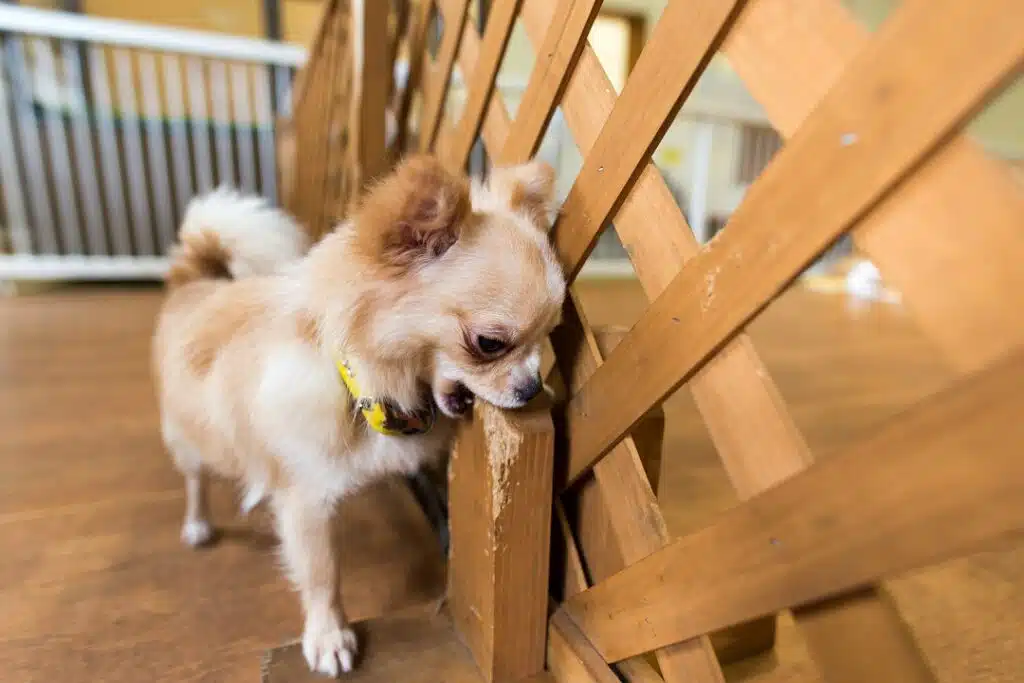
- Teething. This is the phase when a young pup is losing his 28 deciduous teeth (also known as puppy teeth or milk teeth) as 42 adult teeth are pushing through; it typically causes intense itching and discomfort that results in strong chewing urges.
- Boredom. Dogs have limited choices when they are bored. They can take a nap or try to keep themselves busy with what is available to them. Without good alternatives, chewing things up usually helps pass the time.
- Restlessness. This involves having pent-up energy and a strong desire to engage in physical activity but without a proper outlet. This agitation may then be directed toward ripping up or gnawing at non-toy items.
- Stress. When under duress, a dog will employ one of several coping mechanisms including excessive barking, self-licking, and destructive chewing. This is most common with dogs that are left home alone or have limited interaction with their owners.
How to Stop Destructive Chewing
1. Help your Chihuahua meet exercise requirements.
All dogs have a certain amount of energy and if they are not allowed to release it in a healthy manner, that restlessness will manifest in other ways such as destructive chewing. Being brought outside to burn off that pent-up energy allows a dog to feel calmer once back inside the house.
For this reason, take your Chihuahua for at least two 20-minute walks per day at a pace that keeps your dog trotting along at a brisk pace. If you are already doing this, add 10 minutes onto each of the two walks or incorporate a third walk. In addition to this, a 15 to a 20-minute session of moderate cardio, such as playing fetch is beneficial.
2. Create a calm atmosphere.
Households with lots of chaos and noise can get a dog riled up. If this is combined with a lack of interaction and/or attention, there can be developing tension that manifests as destructive chewing.
While all homes will have some level of noise and commotion, try to limit loud blaring TVs, music, or any yelling. If there is lots of foot traffic, boisterous children playing, or other such disturbances, allowing your Chihuahua to have a quiet place to retreat to can help (details ahead in point #4).
3. Proof the house.
The goal is to identify chewing targets that are accessible to your Chihuahua and relocate them. This may mean placing them up high on shelves or in closets and includes shoes, gym bags, small trash cans, or any other non-toy objects that your Chihuahua tends to chew.
Electrical cords should be wrapped with a chew-proof concealer wrap like the PetCords Cord Protector.
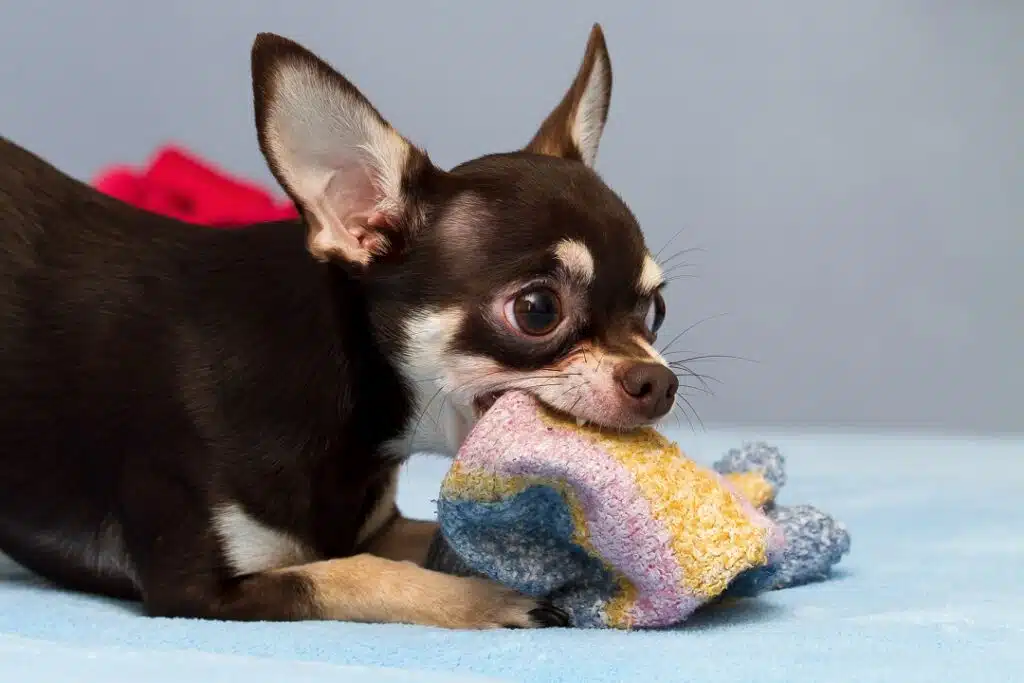
4. Have a designated area for your Chihuahua.
Dogs that having chewing issues should not be allowed to roam the house or even a full room. Unless you could clear the entire room of non-toy objects, this just leaves too much temptation.
For any time that you cannot closely supervise, it is best to have your Chihuahua in a defined area where you can control what your dog will mouth. For this, a canine playpen is recommended. This will offer enough space as to not feel claustrophobic yet keep things contained.
There will be 4 main areas within the playpen: Eating and drinking area (food and water bowls), resting and sleeping area (a quality bed), play area (lots of chew toys; this is covered ahead) and bathroom area (pee pads; applicable for untrained pups and dogs of all ages if there is a chance of bathroom needs while in the defined area).
For puppies and small adults, one like the IRIS 24” 4-Panel Pet Playpen with a Door can work well. This is made of a heavy-duty resin, offers 8 square feet of space, and has a door for easy entrance. If you find that your want your Chi to have more space later, you can make this larger via add-on panels.
If a Chihuahua is on the large side or has proven to be a good jumper, a higher once such as the IRIS 34″ 8-Panel Pet Playpen with a Door can be a good option.
The best place for the pen is a quiet corner of a room frequently used by the family, such as a living room or kitchen.
5. Prevent chewing on pee-pads, if applicable.
If your Chihuahua rips apart their pee pads, there are a couple of ways to prevent this. One option is to place the pee pads within a sturdy holder tray like the Blyss Pets Indoor Dog Potty Tray. These have a mesh top that is gentle on the paws (and keeps them dry) but allows urine to drain through to the pad below.
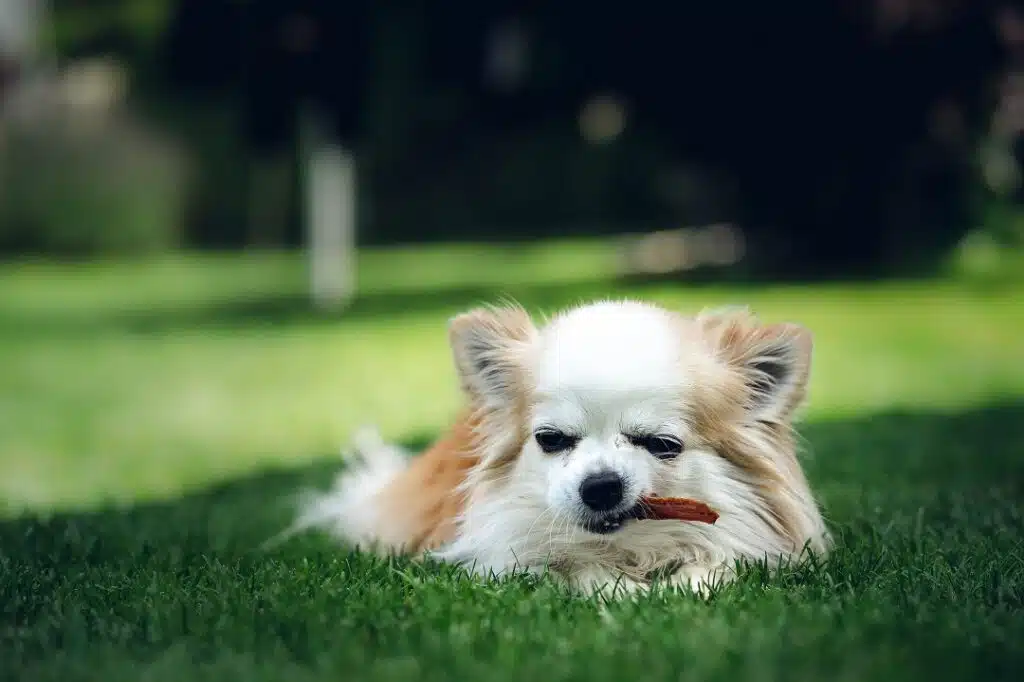
Or, you may wish to make a switch to another method such as a grass mat that dogs won’t rip up like they do with pads. There are artificial ones like the MTBRO Artificial Grass Rug for Dogs. The plus to this is that you only purchase it one time but the con is that you need to keep cleaning it.
And there are real grass mats like the DoggieLawn Disposable Dog Potty with Real Grass. The pro to this is that dogs tend to like going to the bathroom on real grass and there is nothing to clean since you toss it away after one or two weeks. But, that is also a con, since you need to buy one every couple of weeks.
6. Arm your Chihuahua with the right chew toys.
Chew toys should be thought of as tools and a Chihuahua that aggressively chews needs the right ones to get the job done, which is to satisfy chewing urges. Without effective ones, a dog is set up for failure and has no other alternative than to look to non-toy objects.
Any toys that are not currently working to quell chewing urges should be placed aside since having a large collection of useless toys can make it difficult for a dog to reach the helpful ones.
For teething puppies, it is best to offer a wide range of different textures and shapes so that the pup can choose which happens to feel good at any one given time. A great example of this is the Nylabone Puppy X-Bone Chew Toy which has lots of nubs and grooves and best of all it has beef flavor throughout it to encourage chewing.
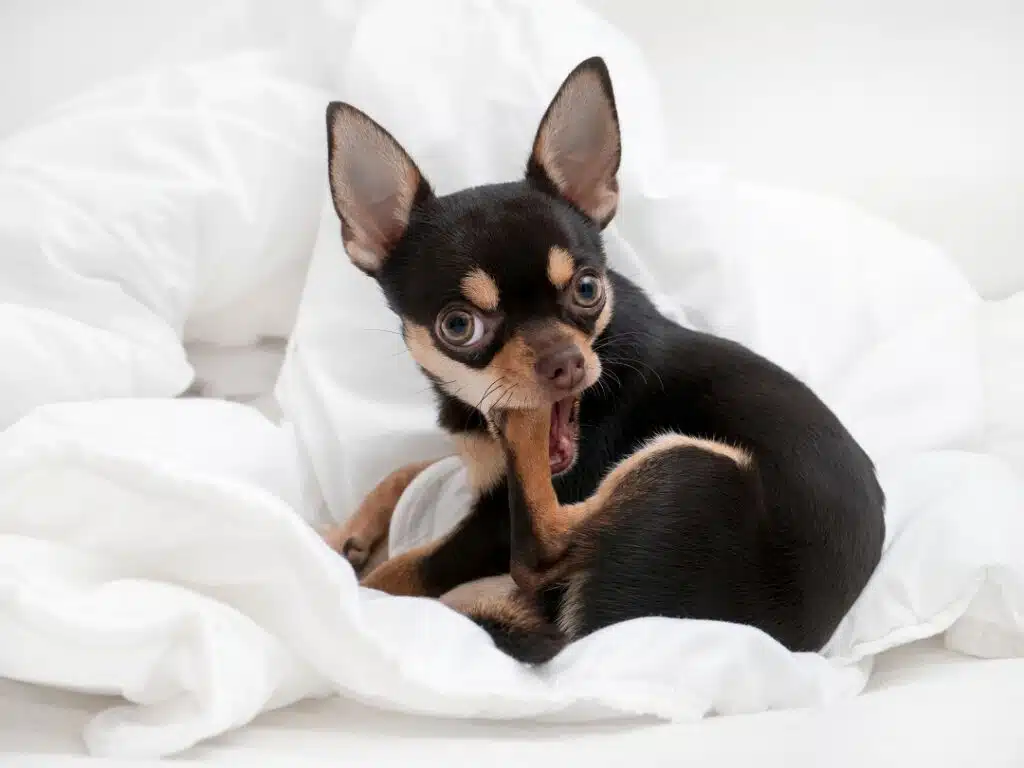
Twisted rope toys, like those found in the Alvi & Remi Puppy Teething Rope Set, can be fantastic as well. A helpful tip is to wet the rope toy, place it in the freezer for about an hour, and offer it to your puppy once it’s chilled. The cold will help reduce teething pain.
For adult Chihuahuas with strong chewing urges, these should be durable and textured to please a chewing machine. Additionally, and exceedingly important to the entire method of helping with chewing issues, is that the toy must be designed to promote engagement and hold a dog’s interest.
A great one for aggressive chewers is the cleverly designed Busy Buddy Bouncy Bone Dog Toy. This has a bouncy ball in the middle, two treat rings on either side, and two ‘bone’ chews on the ends, all made of tough nylon and natural rubber to withstand sharp teeth and strong jaws. The treats draw a dog in, and the taste, bounce factor, and interesting textures keep them happily occupied. This is designed specifically for small dogs under 10 lbs., so it’s perfect for Chihuahuas.
Those that release treats can be super-helpful and conquer two issues at one time: wanting a snack and chewing due to boredom. The Zogoflex Tux Treat Dispensing Chew Toy is a good choice for this. It’s super tough and you can stuff it with anything that your Chi really loves including a mixture of their kibble and peanut butter or mashed bananas. If you want the food inside to last a while, once you have it filled, place it in the freezer for an hour.
7. Use a deterrent spray for large immovable objects, if applicable.
In the case of a Chihuahua chewing on table legs or other large things in the house that cannot be moved elsewhere, the two elements of keeping the dog within a defined area (previous tip #4) and reacting to chewing attempts (upcoming tip #8) are the most effective methods of addressing this.
This said you may wish to use a deterrent spray on certain chewing targets. These contain particular flavoring agents, most often a bitter taste, designed to taste unpleasant and therefore deter chewing. For some reason, some dogs do not mind bitter flavors or may only find one, such as citrus or apple, to be offensive.
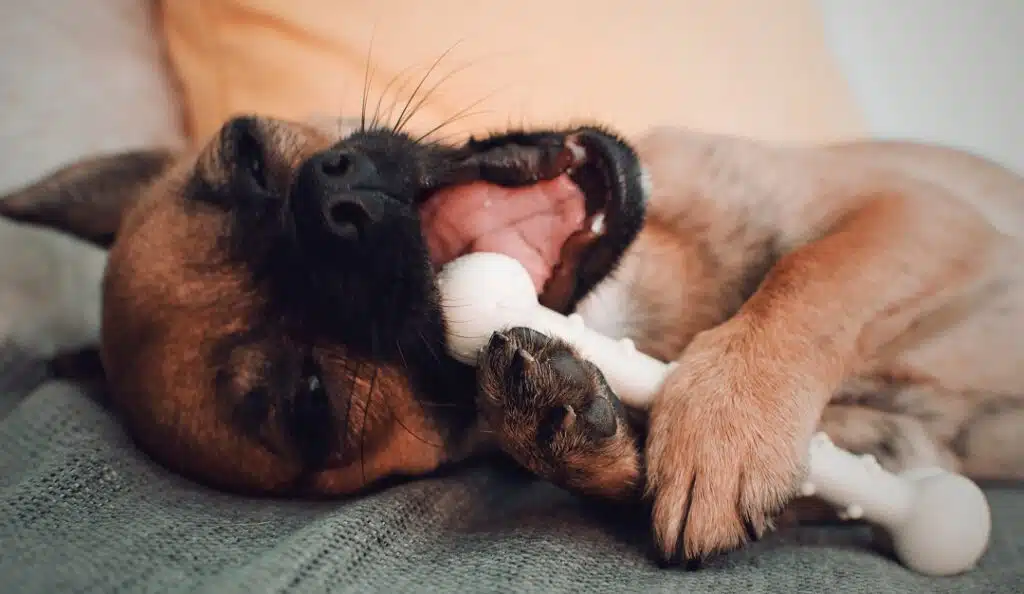
If you want to give it a try, Grannicks Bitter Apple Deterrent Spray is one of the more popular ones.
8. React appropriately to chewing.
Overview: If you’ve followed these steps so far by ensuring your Chihuahua has enough exercise opportunities, the house is not chaotic, the house has been proofed, you have a defined area to keep your little guy or gal when you cannot supervise, and there are plenty of satisfying chew toys, the remaining issue will be attempted at chewing household objects while you are there to take action.
Method: The 3 steps are 1) Interrupt 2) Redirect and 3) Praise. This is a primary training approach that works very well for many behaviors aside from chewing, such as excessive barking, jumping up, etc. Let’s take a look at these steps.
1) Interrupt: Anytime that your Chihuahua makes a motion to attack and chew on a non-toy object, interrupt this. For some dogs, a loud and firm ‘No’ coupled with a hand clap will work.
However, if a dog is quite used to hearing no, he may be unaffected by this. In these cases, it can be helpful to use a training tool designed explicitly for this like The Company of Animals Pet Corrector. This lets out a short hissing noise that causes a dog to take pause. It’s perfectly harmless and does the job.
2) Redirect: The moment that your Chihuahua has taken a pause, redirect his focus to something that he will find to be pleasing and perhaps even more enjoyable than what he was just chewing on.
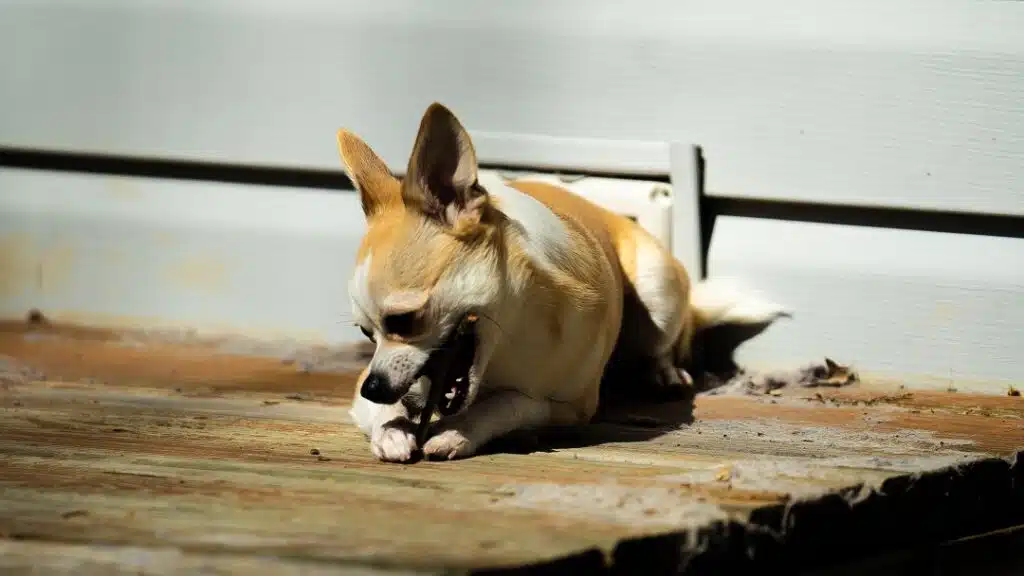
You may find that one of two things works best: You can have this be one of your dog’s favorite toys; in other words, one that you are confident he will be happy to be reminded of. Or, have this be a ‘secret’ toy that you have stashed away, but keep close at hand, to offer just for these circumstances.
For dogs that really need encouragement to mouth the offered toy, dabbing it with a touch of peanut butter beforehand often does the trick. And, do not forget that your level of enthusiasm matters.
3) Praise. While you don’t want to interrupt a dog if he’s happily chewing or playing with an approved toy, if your Chihuahua looks up at you, or takes a short break from chewing the toy, it is a good idea to say, ‘Good, boy/girl!’ in a happy tone and/or give a small pat.

